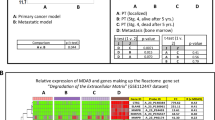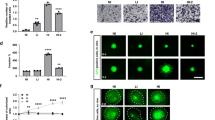Abstract
Meningiomas are common central nervous system tumors; however, the mechanisms underlying their pathogenesis are largely unknown. Collaborative studies from our laboratory demonstrated a direct association of 14-3-3 with the meningioma tumor suppressor Protein 4.1B, which was not observed with other members of the Protein 4.1 family, including the NF2 meningioma tumor suppressor, merlin/schwannomin. Given the role of 14-3-3 in the regulation of cell proliferation and apoptosis, we sought to determine the functional significance of 14-3-3 binding to Protein 4.1B growth suppression. Based on comparative binding studies performed with additional members of the Protein 4.1 family, we generated specific missense mutations within the minimal growth suppressor fragment of Protein 4.1B (DAL-1, differentially expressed in adenocarcinoma of the lung). Complementary in vitro GST affinity chromatography and in vivo interaction experiments demonstrated that the F359Y mutation abrogated binding to 14-3-3, but did not impair DAL-1 binding to other known Protein 4.1B interacting proteins. Similar to wild-type DAL-1, the expression of the F359Y DAL-1 14-3-3-binding mutant resulted in reduced Protein 4.1B-deficient IOMM-Lee and CH157-MN meningioma cell line colony formation. Moreover, similar to wild-type DAL-1, the stable expression of the DAL-1 F359Y mutant significantly reduced cell proliferation in independently isolated IOMM-Lee clones, as assessed by thymidine incorporation. Collectively, these results suggest that binding to 14-3-3 is not essential for the growth suppressor function of Protein 4.1B in meningiomas.
This is a preview of subscription content, access via your institution
Access options
Subscribe to this journal
Receive 50 print issues and online access
$259.00 per year
only $5.18 per issue
Buy this article
- Purchase on Springer Link
- Instant access to full article PDF
Prices may be subject to local taxes which are calculated during checkout





Similar content being viewed by others
References
Charboneau AL, Singh V, Yu T and Newsham IF . (2002). Int. J. Cancer, 100, 181–188.
Chishti AH, Kim AC, Marfatia SM, Lutchman M, Hanspal M, Jindal H, Liu SC, Low PS, Rouleau GA, Mohandas N, Chasis JA, Conboy JG, Gascard P, Takakuwa Y, Huang SC, Benz Jr EJ, Bretscher A, Fehon RG, Gusella JF, Ramesh V, Solomon F, Marchesi VT, Tsukita S, Tsukita S and Hoover KB . (1998). Trends Biochem. Sci., 23, 281–282.
Denisenko-Nehrbass N, Oguievetskaia K, Goutebroze L, Galvez T, Yamakawa H, Ohara O, Carnaud M and Girault JA . (2003). Eur. J. Neurosci., 17, 411–416.
Gimm JA, An X, Nunomura W and Mohandas N . (2002). Biochemistry, 41, 7275–7282.
Goutebroze L, Brault E, Muchardt C, Camonis J and Thomas G . (2000). Mol. Cell. Biol., 20, 1699–1712.
Gutmann DH, Donahoe J, Perry A, Lemke N, Gorse K, Kittiniyom K, Rempel SA, Gutierrez JA and Newsham IF . (2000). Hum. Mol. Genet., 9, 1495–1500.
Gutmann DH, Giordano MJ, Fishback AS and Guha A . (1997). Neurology, 49, 267–270.
Gutmann DH, Haipek CA, Burke SP, Sun CX, Scoles DR and Pulst SM . (2001b). Hum. Mol. Genet., 10, 825–834.
Gutmann DH, Hirbe AC, Huang ZY and Haipek CA . (2001a). Neurobiol. Dis., 8, 266–278.
Huynh DP, Mautner V, Baser ME, Stavrou D and Pulst SM . (1997). J. Neuropathol. Exp. Neurol., 56, 382–390.
Lee WH . (1990). Neurosurgery, 27, 389–395.
Leone PE, Bello MJ, de Campos JM, Vaquero J, Sarasa JL, Pestana A and Rey JA . (1999). Oncogene, 18, 2231–2239.
McBride AE and Silver PA . (2001). Cell, 106, 5–8.
Morrison H, Sherman LS, Legg J, Banine F, Isacke C, Haipek CA, Gutmann DH, Ponta H and Herrlich P . (2001). Genes Dev., 15, 968–980.
Muslin AJ and Xing H . (2000). Cell Signal., 12, 703–709.
Perry A, Cai DX, Scheithauer BW, Swanson PE, Lohse CM, Newsham IF, Weaver A and Gutmann DH . (2000). J. Neuropathol. Exp. Neurol., 59, 872–879.
Robb VA, Li W, Gascard P, Perry A, Mohandas N and Gutmann DH . (2003). Neurobiol. Dis., 13, 191–202.
Ruttledge MH, Sarrazin J, Rangaratnam S, Phelan CM, Twist E, Merel P, Delattre O, Thomas G, Nordenskjold M, Collins VP, Dumanski JP and Rouleau GA . (1994). Nat. Gen., 6, 180–184.
Schulze KM, Hanemann CO, Muller HW and Hanenberg H . (2002). Hum. Mol. Genet., 11, 69–76.
Scoles DR, Huynh DP, Chen MS, Burke SP, Gutmann DH and Pulst SM . (2000). Hum. Mol. Genet., 9, 1567–1574.
Scoles DR, Nguyen VD, Qin Y, Sun CX, Morrison H, Gutmann DH and Pulst SM . (2002). Hum. Mol. Genet., 11, 3179–3189.
Sherman L, Xu HM, Geist RT, Saporito-Irwin S, Howells N, Ponta H, Herrlich P and Gutmann DH . (1997). Oncogene, 15, 2505–2509.
Sun CX, Haipek C, Scoles DR, Pulst SM, Giovannini M, Komada M and Gutmann DH . (2002). Hum. Mol. Genet., 11, 3167–3178.
Tran YK, Bogler O, Gorse KM, Wieland I, Green MR and Newsham IF . (1999). Cancer Res., 59, 35–43.
Tsai JC, Goldman CK and Gillespie GY . (1995). J. Neurosurg., 82, 864–873.
Tsai JC, Hsiao YY, Teng LJ, Chen CT and Kao MC . (1999). Lasers Surg. Med., 24, 296–305.
Tsukita S, Yonemura S and Tsukita S . (1997). Trends Biochem. Sci., 22, 53–58.
Tzivion G and Avruch J . (2001). J. Biol. Chem., 277, 3061–3064.
Ueki K, Wen-Bin C, Narita Y, Asai A and Kirino T . (1999). Cancer Res., 59, 5995–5998.
Weber RG, Boström J, Wolter M, Baudis M, Collins VP, Reifenberger G and Lichter P . (1997). Proc. Natl. Acad. Sci. USA, 94, 14719–14724.
Yageta M, Kuramochi M, Masuda M, Fukami T, Fukuhara H, Maruyama T, Shibuya M and Murakami Y . (2002). Cancer Res., 62, 5129–5133.
Yu T, Robb VA, Singh V, Gutmann DH and Newsham IF . (2002). Biochem. J., 365, 783–789.
Zhang SH, Kobayashi R, Graves PR, Piwnica-Worms H and Tonks NK . (1997). Proc. Natl. Acad. Sci. USA, 272, 27281–27287.
Acknowledgements
We would like to thank Dr Irene Newsham (Henry Ford Hospital, Detroit, MI, USA) for her insightful advice during the execution of this project. These studies were supported by grants from the National Institutes of Health to DHG (NS35848 and NS41520) and VAR (1-F32-CA-097816-01), and from the US Army to DHG (17-02-1-0645).
Author information
Authors and Affiliations
Corresponding author
Rights and permissions
About this article
Cite this article
Robb, V., Li, W. & Gutmann, D. Disruption of 14-3-3 binding does not impair Protein 4.1B growth suppression. Oncogene 23, 3589–3596 (2004). https://doi.org/10.1038/sj.onc.1207445
Received:
Revised:
Accepted:
Published:
Issue Date:
DOI: https://doi.org/10.1038/sj.onc.1207445
Keywords
This article is cited by
-
Tumor suppressor role of protein 4.1B/DAL-1
Cellular and Molecular Life Sciences (2014)
-
Pathological classification and molecular genetics of meningiomas
Journal of Neuro-Oncology (2010)
-
FRMD3, a novel putative tumour suppressor in NSCLC
Oncogene (2007)
-
Induction of caspase-independent apoptosis in H9c2 cardiomyocytes by adriamycin treatment
Molecular and Cellular Biochemistry (2005)
-
DAL-1/4.1B tumor suppressor interacts with protein arginine N-methyltransferase 3 (PRMT3) and inhibits its ability to methylate substrates in vitro and in vivo
Oncogene (2004)



